南航戴华《矩阵论》第五章Hermite矩阵与正定矩阵30页PPT
- 格式:ppt
- 大小:4.53 MB
- 文档页数:30

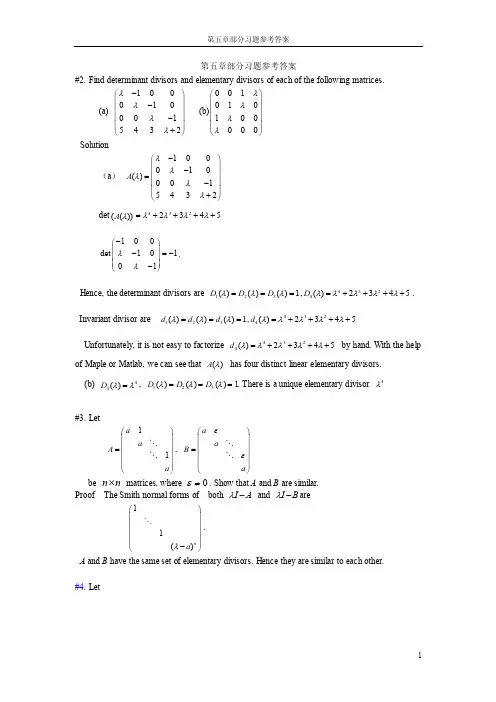
第五章部分习题参考答案#2. Find determinant divisors and elementary divisors of each of the following matrices.(a) 1000100015432λλλλ-⎛⎫ ⎪-⎪ ⎪- ⎪+⎝⎭ (b)001010100000λλλλ⎛⎫⎪ ⎪ ⎪ ⎪⎝⎭Solution(a ) 100010()0015432A λλλλλ-⎛⎫ ⎪- ⎪= ⎪- ⎪+⎝⎭det (())A λ4322345λλλλ=++++100det 10101λλ-⎛⎫⎪-=- ⎪ ⎪-⎝⎭. Hence, the determinant divisors are 123()()()1D D D λλλ===,4324()2345D λλλλλ=++++. Invariant divisor are 123()()()1d d d λλλ===,4324()2345d λλλλλ=++++Unfortunately, it is not easy to factorize 4324()2345d λλλλλ=++++ by hand. With the help of Maple or Matlab, we can see that ()A λ has four distinct linear elementary divisors. (b) 44()D λλ=, 123()()()1D D D λλλ===. There is a unique elementary divisor 4λ #3. Let11a a A a ⎛⎫ ⎪ ⎪= ⎪ ⎪⎝⎭ , a a B a εε⎛⎫ ⎪⎪= ⎪ ⎪⎝⎭ be n n ⨯ matrices, where 0ε≠. Show that A and B are similar.Proof The Smith normal forms of both I A λ- and I B λ-are11()n a λ⎛⎫ ⎪⎪ ⎪ ⎪-⎝⎭. A and B have the same set of elementary divisors. Hence they are similar to each other. #4. Let11a a A a ⎛⎫ ⎪ ⎪= ⎪ ⎪⎝⎭ , 11a a B a ε⎛⎫ ⎪⎪= ⎪ ⎪⎝⎭be n n ⨯ matrices, where 0ε≠. Show that A and B are NOT similar. ProofThe determinant of I A λ- is ()n a λ- . The determinant of I B λ- is ()n a λε--. A and B have distinct characteristic polynomials. Hence, they are not similar.#11. How many possible Jordan forms are there for a 66⨯ complex matrix with characteristic polynomial 42(2)(1)x x +-?Solution The possibilities for the sets of elementary divisors are { 42(2),(1)x x +-}, {4(2),(1),(1)x x x +--}{32(2),(2),(1)x x x ++-}, {3(2),(2),(1),(1)x x x x ++--} {222(2),(2),(1)x x x ++-}, {22(2),(2),(1),(1)x x x x ++--},{22(2),(2),(2),(1)x x x x +++-}, {2(2),(2),(2),(1),(1)x x x x x +++--}{2(2),(2),(2),(2),(1)x x x x x ++++-}, {(2),(2),(2),(2),(1),(1)x x x x x x ++++--}. For each set of elementary divisors, there is a Jordan canonical form up to similarity. There are 10 Jordan canonical forms up to similarity.#12. Classify up to similarity all 33⨯ complex matrices A such that 3A I =. Solution An annihilating polynomial of A is 321(1)()()x x x x ωω-=---, where ω A is diagonalizable.The possibilities for the minimal polynomial of A are1x -, x ω-, 2x ω-;(1x -)(x ω-), (x ω-)(2x ω-), (1x -)(2x ω-);2(1)()()x x x ωω---Up to similarity, all 33⨯ complex matrices A are100010001⎛⎫ ⎪ ⎪ ⎪⎝⎭, 000000ωωω⎛⎫⎪ ⎪ ⎪⎝⎭, 222000000ωωω⎛⎫ ⎪ ⎪ ⎪⎝⎭; 10001000ω⎛⎫⎪ ⎪ ⎪⎝⎭, 1000000ωω⎛⎫ ⎪ ⎪ ⎪⎝⎭; 22000000ωωω⎛⎫ ⎪⎪ ⎪⎝⎭, 2000000ωωω⎛⎫ ⎪ ⎪ ⎪⎝⎭;221000000ωω⎛⎫⎪ ⎪ ⎪⎝⎭,210001000ω⎛⎫⎪ ⎪ ⎪⎝⎭21000000ωω⎛⎫ ⎪ ⎪ ⎪⎝⎭#14. If N is a nilpotent (幂零的) 33⨯ matrix over C , prove that 21128A I N N =+- satisfies2A I N =+, i.e., A is a square root of I N +. Use the binomial series for 1/2(1)t + to obtain asimilar formula for a square root of I N +, where N is any nilpotent n n ⨯ matrix over C .Use the result above to prove that if c is a non-zero complex number and N is a nilpotent complex matrix, then cI N +has a square root. Now use the Jordan form to prove that every non-singular complex n n ⨯ matrix has a square root.Solution If N is an n n ⨯ matrix and k N O =, then k x is an annihilating polynomial for N . The minimal polynomial of N must be of the form p x , where p n ≤ and p k ≤ since the minimal polynomial of a matrix divides its characteristic polynomial. Thus, n N O =.(1) If N is a nilpotent 33⨯ matrix, then 3N O =. By straightforward computation, we can verify that 2A I N =+.(2) If N is an n n ⨯ nilpotent matrix, n N O =.1/22111111(1)(1)((1)1)122222(1)122!(1)!n n t t t t n -----++=+++++- 1/22111111(1)(1)((1)1)122222()22!(1)!n n I N I N N N n -----++=++++-(3) Since1N c is a nilpotent matrix, 1I N c + has a square root 1/21()I N c+. cI N + has a square root 1/21/21()c I N c+.(4) Suppose that 12121()0()000()r d d d r J J P AP J J λλλ-⎛⎫ ⎪⎪==⎪ ⎪ ⎪⎝⎭. Then each ()k d k J λ has asquare root 1/2()k d k J λ since ()k d k J λ is of the form k I N λ+, where 0k λ≠ because A is nonsingular and N is nilpotent.Let 121/211/2211/2()000()000()r d d d r J J B P P J λλλ-⎛⎫⎪⎪=⎪ ⎪⎪⎝⎭, then 2B A =. Hence, A has a squareroot.#20. Prove that the minimal polynomial of a matrix is equal to the characteristic polynomial if andonly if the elementary divisors are relatively prime in pairs.Proof Suppose that a Jordan canonical form of A is1212()000()000()r d d d r J J J J λλλ⎛⎫⎪ ⎪=⎪ ⎪ ⎪⎝⎭(where 12,,,r λλλ are not necessarily distinct. Each ()i d i J λ is a Jordan block.)The minimal polynomial of A is the same as that of J . The characteristic polynomial of A is the same as that of J . The elementary divisors of A are 11()d λλ-, , ()rd r λλ-The minimal polynomial of ()i d i J λ is ()i d i λλ-. The minimal polynomial of J is the least common multiple (最小公倍式) of 11()d λλ-, , ()rd r λλ-. The characteristicpolynomial of J is 1212()()()()rd d d r p λλλλλλλ=--- .The least common divisor of 11()d λλ-, , ()rd r λλ- is equal to the product of11()d λλ-, , ()r d r λλ- if and only if ()j dj λλ-and ()k d k λλ-are relatively prime forj k ≠. Thus the minimal polynomial of a matrix is equal to the characteristic polynomial ifand only if the elementary divisors are relatively prime in pairs.。


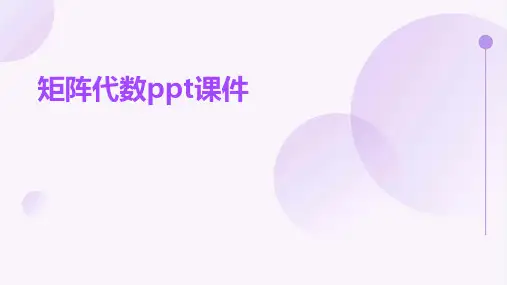

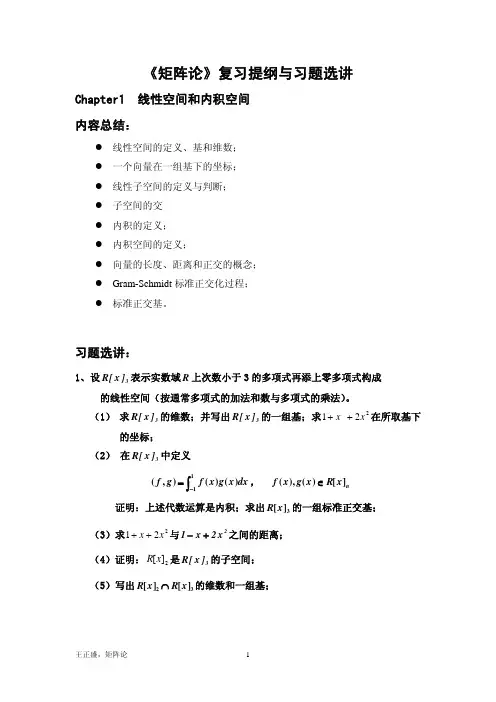
《矩阵论》复习提纲与习题选讲Chapter1 线性空间和内积空间内容总结:z 线性空间的定义、基和维数;z 一个向量在一组基下的坐标;z 线性子空间的定义与判断;z 子空间的交z 内积的定义;z 内积空间的定义;z 向量的长度、距离和正交的概念;z Gram-Schmidt 标准正交化过程;z 标准正交基。
习题选讲:1、设表示实数域3]x [R R 上次数小于3的多项式再添上零多项式构成 的线性空间(按通常多项式的加法和数与多项式的乘法)。
(1) 求的维数;并写出的一组基;求在所取基下的坐标;3]x [R 3]x [R 221x x ++ (2) 在中定义3]x [R , ∫−=11)()(),(dx x g x f g f n x R x g x f ][)(),(∈ 证明:上述代数运算是内积;求出的一组标准正交基;3][x R (3)求与之间的距离;221x x ++2x 2x 1+−(4)证明:是的子空间;2][x R 3]x [R (5)写出2[][]3R x R x ∩的维数和一组基;二、 设22R ×是实数域R 上全体22×实矩阵构成的线性空间(按通常矩阵的加 法和数与矩阵的乘法)。
(1) 求22R ×的维数,并写出其一组基;(2) 在(1)所取基下的坐标; ⎥⎦⎤⎢⎣⎡−−3111(3) 设W 是实数域R 上全体22×实对称矩阵构成的线性空间(按通常矩阵的加法和数与矩阵的乘法)。
证明:W 是22R ×的子空间;并写出W 的维数和一组基;(4) 在W 中定义内积, )A B (tr )B ,A (T =W B ,A ∈求出W 的一组标准正交基;(5)求与之间的距离; ⎥⎦⎤⎢⎣⎡0331⎥⎦⎤⎢⎣⎡−1221 (6)设V 是实数域R 上全体22×实上三角矩阵构成的线性空间(按通常矩阵的加法和数与矩阵的乘法)。
证明:V 也是22R ×的子空间;并写出V 的维数和一组基;(7)写出子空间的一组基和维数。
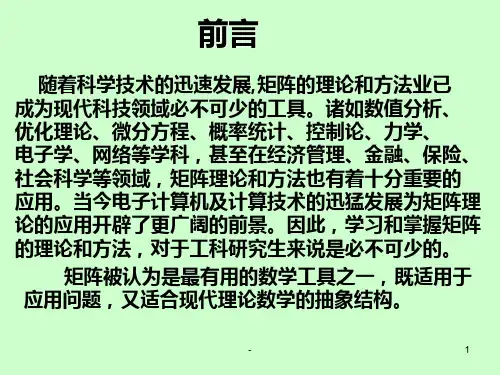

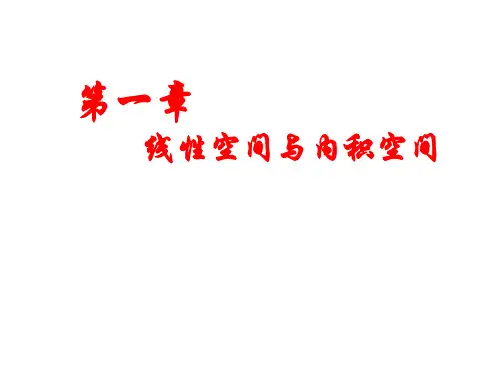
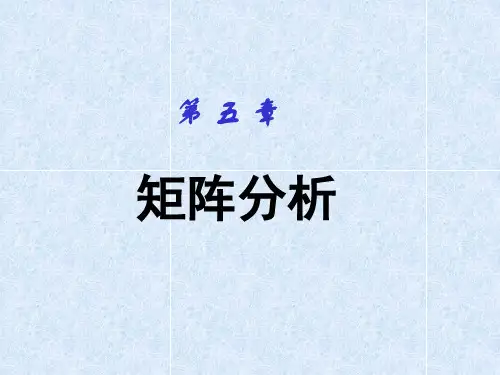
1.线性空间、维数、基与坐标第一章线性空间与内积空间(1)线性空间V 中存在加法和数乘运算,且加法和数乘运算满足8个条件;(2)线性空间V 中线性无关向量的最大个数n 称为V 的维数,记为dim (V ) = n ;V 中任意n 个线性无关向量称为V 的一组基;(3)如果是线性空间V 中的n 个线性无关向量,且V 中任一向量都可由其线性表示,则是V 的一组基且dim (V ) = n ;n ααα,,,21 n ααα,,,21(4)设是线性空间V 的一组基,是V 的n 个向量,则存在n 阶方阵T ,使得n εεε,,,21 n ',,','21εεε ,),,,()',,','(2121T n n εεεεεε =当且仅当T 可逆时,也是V 的一组基;n ',,','21εεε.2211n n x x x εεεα+++= (5)设是线性空间V 的基,则向量α在这组基下的坐标是如下线性组合的系数向量:n εεε,,,21 T n x x x ),,,(212.线性子空间(1)设V 是线性空间,W 是V 的非空子集,则W 是V 的子空间的充分必要条件是;,,,P W k W k ∈+⇒∈∀∈∀βααβα(3)设与是线性空间V 的两组向量,则的充分必要条件是与等价;s ααα,,,21 t βββ,,,21 ),,,(),,,(2121t s L L βββααα =s ααα,,,21 t βββ,,,21 (2)设是线性空间V 的一组向量,则W 是V 的子空间;s ααα,,,21 },P |{),,(221121∈+++==i s s s k k k k L W αααααα);,,,(rank )),,,dim(L(42121s s αααααα =)((5)设V 1, V 2是线性空间V 的两个子空间,则V 1∩V 2和V 1 +V 2也是V 的子空间;(6)如果V 1和V 2是线性空间V 的有限维子空间,则).(dim )(dim )(dim )(dim 212121V V V V V V ∩++=+3.直和的判别法(1)V 1 + V 2中任意向量的分解式唯一;};0{21=V V ∩(3)).dim()dim()dim(2121V V V V +=+(4)(2)V 1+ V 2中零向量的表法唯一;4.内积空间(1)内积是一种代数运算,满足共轭对称性,左侧可加性和齐次性以及非负性;;),(:Cauchy )2(βαβα≤不等式;:)3(βαβα+≤+三角不等式(4)线性无关的充分必要条件是Gram 矩阵非奇异;m ααα,,,21 ()mm i j m G ×=),(),,,(21ααααα (5)线性无关向量组一定可以标准正交化.5.标准正交基的性质(1)有限维内积空间V 的标准正交基一定存在;(2)有限维内积空间V 的任意一组标准正交向量可扩充为V 的一组标准正交基;(3)设是内积空间V 的一组标准正交基,且则n εεε,,,21 ,,1111n n n n y y x x εεβεεα++=++= .),(1∑===ni i i Hy x x y βα6.常见内积空间;),(,)1(1∑====ni i i Hn y x x y y x C V 内积;内积dx x g x f g f b a C V ba )()(),(],,[)2(∫==).(tr ),(,)3(A B B A C V Hn m ==×内积第二章线性映射与线性变换1.线性变换的定义设V 是数域P 的线性空间,A是V 到自身的一个映射,如果则称A是V 的线性变换.P ,),()(,),()()(∈∈∀=∈∀+=+kVkk VαααβαβαβαAA AAA2.线性变换的性质. ,, ,,的线性变换也是则的线性变换,是如果VkP kVAABB ABA+∈(1)设是线性空间V 的一组基,A 是V 的线性变换,则n εεε,,,21 ⎪⎪⎩⎪⎪⎨⎧+++=+++=+++=nnn n n n n n n n a a a a a a a a a εεεεεεεεεεεε 22112222112212211111)()()(A A A 3.线性变换的矩阵表示;),,,(),,,(2121A n n εεεεεε =A 即(2)n 维线性空间的线性变换与n 阶矩阵一一对应;(3)同一个线性变换在不同基下的矩阵一定相似.4.线性变换的值域与核设A 是n 维线性空间V 的线性变换,是V 的一组基,A 在这组基下的矩阵是A ,则n εεε,,,21 (1)A 的核为};0)(|{)Ker(=∈=ααA A V };|)({)(V R ∈=ααA A (2)A 的值域为));(,),(),(()(321n L R εεεA A A A =)((4)dim(R (A )) = rank( A );(5)dim(R (A )) + dim(Ker(A )) = n .5.矩阵A 可对角化的充分必要条件(1)A 有n 个线性无关的特征向量;(2)设A 的全部互异特征值为,则r λλλ,,,21 ;)dim()dim()dim(21n V V V r =+++λλλ (3)A 的每一个特征值的几何重数等于代数重数;(4)A 的初等因子都是一次式;(5)A 的最小多项式m (λ) 没有重零点.6.酉变换和酉矩阵设A 是n 维酉空间V 的线性变换,则下列命题等价:(1)A 是酉变换,即;),())(),((βαβα=A A ,)()2(αα=A ;V ∈∀α的一组标准正交基,则是如果V n εεε,,,)3(21 )(,),(),(21n εεεA A A 的一组标准正交基;也是V (4)A 在V 的标准正交基下的矩阵是酉矩阵.(1)存在数字矩阵P 与Q ,使得;)(Q B I P A I −=−λλ(2)它们的特征矩阵λI -A 和λI -B 相抵;(4)它们有相同的行列式因子;1.数字矩阵A 与B 相似的条件第三章λ矩阵与矩阵的Jordan 标准形(5)它们有相同的初等因子.(3)它们有相同的不变因子;2. 矩阵的最小多项式(1)矩阵A 的最小多项式m (λ) 能整除A 的任一化零多项式;(2)矩阵A 的最小多项式能整除特征多项式f (λ);(3)是A 的特征值的充分必要条件是;0λ0)(0=λm (4)相似的矩阵具有相同的最小多项式;(5)矩阵A 的最小多项式为其最后一个不变因子.3.矩阵的不变因子、行列式因子和初等因子的求法(1)化λI -A 为Smith 标准形:)),(,),(),(diag(21λλλλn d d d A I ≅−则是A 的n 个不变因子;)(,),(),(21λλλn d d d ⎪⎪⎩⎪⎪⎨⎧===),()()()(),()()(),()(2121211λλλλλλλλλn n d d d D d d D d D (2)令则是A 的n 个行列式因子;)(,),(),(21λλλn D D D(3)将矩阵A 的不变因子进行标准分解,则全体一次因式的方幂)(,),(),(21λλλn d d d sn s n n )(,,)(,)(2121λλλλλλ−−− 即为A 的全部初等因子.4.Jordan 标准形的求法(1)求矩阵A 的初等因子;)(,,)(,)(2121sn s n n λλλλλλ−−− ).,,,(diag 21s J J J J =(3)A 的Jordan 标准形为(2)对A 的每个初等因子构造Jordan 块:in i )(λλ−;1001i i n n i i i i J ×⎟⎟⎟⎟⎠⎞⎜⎜⎜⎜⎝⎛=λλλ第四章矩阵的因子分解1.满秩分解设m ×n 矩阵A 的秩为r≥1,则存在m ×r 列满秩矩阵B和r ×n 行满秩矩阵C,使得A = BC.2.三角分解(1)LU分解:设A 的各阶顺序主子式非零,则存在唯一的单位下三角矩阵L 和上三角矩阵U,使得A = LU.3.QR 分解(1)设A 是n 阶非奇异实矩阵,则存在酉矩阵Q 和非奇异上三角矩阵R ,使得A = QR ;(2)LDU 分解:设A 的各阶顺序主子式非零,则存在唯一的单位下三角矩阵L ,单位上三角矩阵U 和对角矩阵D = diag(d 1,d 2,…,d n ),使得A = LDU ,并且.,,2,)()(,1111n k A A d a d k k k =ΔΔ==−(2)设A 是m ×n 列满秩矩阵,则存在m ×n 列正交规范矩阵Q 和n 阶非奇异上三角矩阵R ,使得A = QR ;4.Schur 定理(正交分解)(1)设A 是n 阶复矩阵,则存在n 阶酉矩阵U 和n阶上三角矩阵R ,使得U H AU = R ;.,行满秩矩阵是列正交规范矩阵是其中n r R r m Q ××(3)设A 是矩阵且,则A 有分解式:n m ×,QR A =0)(rank >=r A (2)设A 是n 阶实矩阵,则存在n 阶正交矩阵Q 和n 阶块上三角矩阵R ,使得Q T AQ = R .5.奇异值分解.,,),,,(diag 11的正奇异值是且其中A r r σσσσ =Σ设A 是m ×n 实(复)矩阵,且rank (A ) = r ,则存在m 阶正交(酉)矩阵V 和n 阶正交(酉)矩阵U ,使得,000000⎟⎟⎠⎞⎜⎜⎝⎛⎟⎟⎠⎞⎜⎜⎝⎛Σ=⎟⎟⎠⎞⎜⎜⎝⎛Σ=AU V AU V H T6.正规矩阵的性质(1)n 阶矩阵A 酉相似于对角矩阵的充分必要条件为A 是正规矩阵;(2)设A, B 均为n 阶正规矩阵且AB =BA,则存在n 阶酉矩阵U,使得U H AU与U H BU同时为对角矩阵;(3)若A是正规矩阵,则A 的属于不同特征值的特征向量正交;(4)若A是正规矩阵,则A 的奇异值是A 的特征值的模.第五章Hermite矩阵与正定矩阵1.Hermite矩阵的性质(1) 如果A 是Hermite矩阵,则对正整数k,A k也是Hermite矩阵;(2) 如果A 是可逆Hermite矩阵,则A-1是Hermite矩阵;(3) 若A, B 是Hermite矩阵,则AB 是Hermite矩阵的充分必要条件是AB = BA;(4) 若A 是Hermite矩阵,则对任意方阵S,S H AS 也是Hermite矩阵;(5)设A 为n 阶Hermite 矩阵,则A 的所有特征值全是实数;(6)设A 为n 阶Hermite 矩阵,则A 的属于不同特征值的特征向量互相正交;(7)A 为n 阶Hermite 矩阵的充分必要条件是存在酉矩阵U 使得),,,,(diag 21n H AU U λλλ =Λ=.,,,21均为实数其中n λλλ2. Hermite 矩阵正定的判别方法(1) A 的n 个特征值均为正数;(2) 存在n 阶可逆矩阵P ,使得P HAP = I ;(3) 存在n 阶可逆矩阵Q ,使得A = Q H Q ;(4) 存在n 阶可逆Hermite 矩阵S ,使得A = S 2;(5)A 的顺序主子式均为正数,即;,,1,0)(n k A k =>Δ(6)A 的所有主子式全大于零.3.正定矩阵的性质则其特征值为阶正定矩阵是设,,,,,21n n A λλλ 是正定矩阵;1)1(−A ;0,)2(>×AQ Q m n Q H 则列满秩矩阵是任一如果;,,2,1,)tr(;0)3(n i A A i =>>λ(4) 设A ,B 均为n 阶Hermite 矩阵,且B > 0,则存在可逆矩阵P ,使得.),,,,(diag 21I BP P AP P Hn H ==λλλ4. Hermite 矩阵半正定的判别方法(1)A 的n 个特征值均为非负数;;0002⎟⎟⎠⎞⎜⎜⎝⎛=r H I AP P P n 使得阶可逆矩阵)存在(;)3(Q Q A Q r H=使得的矩阵存在秩为;,Hermite 42S A S n r =使得矩阵阶的)存在秩为((5)A 的所有主子式均非负.5.矩阵不等式;0)1(≥−⇔≥B A B A ;,)2(Bx x Ax x C x B A H H n ≥∈∀⇔≥有都有阶可逆矩阵对任意P n B A B A ⇔>≥)()4();(BP P AP P BP P AP P H H H H >≥则设),,,(diag ),,,(diag )3(11n n b b B a a A ==);,,2,1)(()(n i b a b a B A B A i i i i =>≥⇔>≥(5)设A , B 均为n 阶Hermite 矩阵且A ≥0, B >0,则;1)(1≤⇔≥−AB A B ρ;1)(1<⇔>−AB A B ρ(6)设A 是n 阶Hermite 矩阵,则;)()(max min I A A I A λλ≤≤(8)设A , B 均为n 阶Hermite 矩阵,且AB = BA ,则;022B A B A ≥⇒≥≥;022B A B A >⇒>>.0,0,0)10(≥=≥≥AC CA AC C A 则且设;0,0,0)9(>=>>AC CA AC C A 则且设(7)设A 是Hermite 非负定矩阵,则A ≤tr(A ) I ;第六章范数与极限1.向量范数;2)2(21122⎟⎟⎠⎞⎜⎜⎝⎛=−∑=ni ix x 范数;1)1(11∑==−ni i x x 范数;max )3(1i ni x x ≤≤∞=−∞范数.1,)4(11>⎟⎟⎠⎞⎜⎜⎝⎛=−∑=p x xp pni pi p范数2.矩阵范数;||max 1)1(111∑=≤≤=−mi ij nj a A 范数;)]([2)2(21max 2A A A Hλ=−范数;||max )3(111Hnj ij mi Aa A ==−∞∑=≤≤∞范数().)(||)4(2121112A A tr a A F H m i nj ij F=⎟⎟⎠⎞⎜⎜⎝⎛=−∑∑==范数3.矩阵范数与向量范数的联系,则且设∞=∈×,2,1p CA nm .max 1p x p Ax A p==;)1(p ppB AAB≤;)2(22B A AB F ≤.)3(2F FB A AB≤4.矩阵范数的相容性则且设,,,2,1,,F p CB CA kn nm ∞=∈∈××;)3(p pppA UAVAVUA===;)1(p pTpHA AA==;)2(222A A A H=5.矩阵范数的性质.)4(122∞≤A A A 则是酉矩阵和设,,2,,F p V U CA nm =∈×6.矩阵的谱半径;)(,,)1(A A CC A nn nn ≤⋅∈××ρ有上的任一相容矩阵范数则对设;)(,,0,)2(ερε+≤⋅>∀∈××A A CCA nn nn 使得上存在相容矩阵范数在则设.,)(,)3(R A CR A CA nn nn <⋅<∈××使得存在相容矩阵范数上的充分必要条件是在则设ρ7.矩阵序列与矩阵级数;0lim lim lim )1()()()(=−⇔=⇔=∞→∞→∞→A Aa a A Ak k ij k ijk k k ;,;,发散则如果绝对收敛则如果的收敛半径为设级数∑∑∑∞=∞=∞=><0)(,)()2(k kk k kkk kk A c R A A cR A R z c ρρ;0lim 1)()3(0=⇔<⇔∞→∞=∑kk k kA A Aρ收敛矩阵幂级数.,1,)4(1可逆则的相容矩阵范数且上是,是非奇异矩阵设E A E A CCE CA nn nn nn +<⋅∈∈−×××1.加号逆的定义;1A AGA =)(;2G GAG =)(;)(3AG AG T=)(.)(4GA GA T=)(设A ∈R m ×n ,则G =A +的充分必要条件是:第八章广义逆矩阵2.加号逆在方程组中的应用;)1(b b AA b Ax ==+相容的充要条件是方程组则其通解是相容若,)2(b Ax =是则其最小二乘解的通式不相容若,)4(b Ax =;,)3(是其极小范数解则相容若b A x b Ax +==;,)(nR y y A A I b A x ∈∀−+=++;,)(nR y y A A I b A x ∈∀−+=++.,)5(b A x b Ax +==则其极小最小二乘解是不相容若3.加号逆在矩阵方程中的应用;C B CB AA =++(1)矩阵方程AXB = C 有解的充分必要条件是.,Y AYBB A Y CB A X ∀−+=++++(2)如果AXB = C 有解,则其通解是4.加号逆的计算;)(,)1(1TT A A A A A −+=则列满秩若;)(,)2(1−+=T T AA A A A 则行满秩若(3)设A 的满秩分解为A = BC ,则.)()(11TTT TB B B CC C B C A −−+++==。
第五章部分习题参考答案Exercise 2Find determinant divisors and elementary divisors of each of the following matrices.(a) 1000100016733λλλλ-⎛⎫ ⎪- ⎪ ⎪- ⎪--+⎝⎭ (b)001010100000λλλλ⎛⎫⎪ ⎪ ⎪ ⎪⎝⎭ Solution(a ) 100010()0016733A λλλλλ-⎛⎫ ⎪-⎪= ⎪- ⎪--+⎝⎭det (())A λ432323376(1)(46)λλλλλλλλ=+--+=-++-222(1)(56)(1)(2)(3)λλλλλλ=-++=-++There is a 3x3 submatrix whose determinant is100det 10101λλ-⎛⎫ ⎪-=- ⎪ ⎪-⎝⎭. Hence, the determinant divisors are 123()()()1D D D λλλ===,4324()3376D λλλλλ=+--+. Invariant divisor are 123()()()1d d d λλλ===,4324()3376d λλλλλ=+--+ The elementary divisors of ()A λ are 2(1)λ-, 2λ+, 3λ+(b) 44()D λλ=, 123()()()1D D D λλλ===. There is a unique elementary divisor 4λExercise 3Let11a a A a ⎛⎫ ⎪ ⎪= ⎪ ⎪⎝⎭ , a a B a εε⎛⎫ ⎪⎪= ⎪ ⎪⎝⎭be n n ⨯ matrices, where 0ε≠. Show that A and B are similar.Proof The Smith normal forms of both I A λ- and I B λ-are11()n a λ⎛⎫ ⎪⎪ ⎪ ⎪-⎝⎭.A andB have the same set of elementary divisors. Hence they are similar to each other.Exercise 4Let11a a A a ⎛⎫ ⎪ ⎪= ⎪ ⎪⎝⎭ , 11a a B a ε⎛⎫ ⎪⎪= ⎪ ⎪⎝⎭be n n ⨯ matrices, where 0ε≠. Show that A and B are NOT similar.ProofThe determinant of I A λ- is ()n a λ- . The determinant of I B λ- is ()n a λε--. A and B have distinct characteristic polynomials. Hence, they are not similar.Exercise 6For each of the following matrices, find the Jordan Canonical Form J and matrix P such that 1P AP J -=(a) 040140122-⎛⎫ ⎪- ⎪ ⎪--⎝⎭(b)134478677-⎛⎫⎪- ⎪ ⎪-⎝⎭Solution(a)40140122I A λλλλ⎛⎫ ⎪-=-+ ⎪ ⎪-+⎝⎭Determinant divisors are 33()det()(2)D I A λλλ=-=+, 2()det()(2)D I A λλλ=-=+,1()1D λ= Invariant divisors are 23()(2)d λλ=+, 2()(2)d λλ=+, 1()1d λ= Elementary divisors are 2(2)λ+, (2)λ+A Jordan canonical form is 210020002-⎛⎫⎪- ⎪ ⎪-⎝⎭. Let123(,,)p p p P =, then1121233222p p p p p p p A A A =-=-=-Solving (2)x 0A I +=, that is, 123240012001200x x x -⎛⎫⎛⎫⎛⎫ ⎪⎪ ⎪-= ⎪⎪ ⎪ ⎪⎪ ⎪-⎝⎭⎝⎭⎝⎭, we obtain that {1p ,3p } form abasis for (2)((0,0,1),(2,1,0))T T N I A Span -= . Let 1(2,1,0)(0,0,1),p T T a b =+ To obtain 2p , we solve the system212(2)p p a A I a b ⎛⎫⎪-== ⎪ ⎪⎝⎭, that is,1232402120120y a y a y b -⎛⎫⎛⎫⎛⎫ ⎪⎪ ⎪-= ⎪⎪ ⎪ ⎪⎪ ⎪-⎝⎭⎝⎭⎝⎭. This system is consistent only if a b =. Let 1a b ==. Then 1(2,1,1)p T =, We solve the system above for vector2(1,0,0)p T =. Take 3(0,0,1)p T =.210100101P ⎛⎫ ⎪= ⎪ ⎪⎝⎭(b) 134478677I A λλλλ--⎛⎫ ⎪-=-+- ⎪ ⎪--⎝⎭23()det()(1)(3)D I A λλλλ=-=+-, 2()1D λ= , 1()1D λ=Invariant divisors are 23()(1)(3)d λλλ=+-, 2()1d λ=, 1()1d λ= Elementary divisors are 2(1)λ+, (3)λ-A Jordan canonical form is 110010003-⎛⎫⎪- ⎪ ⎪⎝⎭. Let123(,,)p p p P =, then11212333p p p p p p p A A A =-=-= 3(1,2,2)p T =, 1(1,2,1)p T =, 2(1,1,0)p T =--111212102P -⎛⎫⎪=- ⎪ ⎪⎝⎭Exercise 8Show that if p A I = for some positive integer p , then A is similar to a diagonal matrix over the complex number field.Proof Since p A I =, 1p x - is an annihilating polynomial. The minimal polynomial ()m x of A must divide 1p x -. Since the polynomial 1p x - has only single roots(单根),()m x has only single roots. Therefore, by Theorem 5.2.7 (see lecture notes p124), matrix A is diagonalizable.Exercise 9Prove that if an n n ⨯ matrix satisfies 256A A I -=then A is diagonalizable.Proof Since 256A A I -=, 256x x -- is an annihilating polynomial of A . . The minimal polynomial ()m x of A must divide 256x x --. Since 256(6)(1)x x x x --=-+, the minimal polynomial must be a product of distinct linear factors. By Theorem 5.2.7 (see lecture notes p124), matrix A is diagonalizable.Exercise 10Show that if A is nonsingular, then 1A - can be written as a polynomial of A .Proof Let 1110()n n n p x c c c λλλ--=++++ be the characteristic polynomial of A . The constant term of ()p x must not be zero since A is nonsingular. By Cayley-Hamilton Theorem,()p A O =. That is, 1110n n n A c A c A c I O --++++= . Thus,1121101()n n n A A c A c I c ----=-+++ , which is a polynomial of A .Exercise 11How many possible Jordan forms are there for a 66⨯ complex matrix with characteristic polynomial 42(2)(1)x x +-?Solution The possibilities for the sets of elementary divisors are { 42(2),(1)x x +-}, {4(2),(1),(1)x x x +--}{32(2),(2),(1)x x x ++-}, {3(2),(2),(1),(1)x x x x ++--} {222(2),(2),(1)x x x ++-}, {22(2),(2),(1),(1)x x x x ++--},{22(2),(2),(2),(1)x x x x +++-}, {2(2),(2),(2),(1),(1)x x x x x +++--}{2(2),(2),(2),(2),(1)x x x x x ++++-}, {(2),(2),(2),(2),(1),(1)x x x x x x ++++--}. For each set of elementary divisors, there is a Jordan canonical form up to similarity. There are 10 Jordan canonical forms up to similarity.Exercise 12Classify up to similarity all 33⨯ complex matrices A such that 3A I =.Solution An annihilating polynomial of A is 321(1)()()x x x x ωω-=---, where ω= A is diagonalizable.The possibilities for the minimal polynomial of A are1x -, x ω-, 2x ω-;(1x -)(x ω-), (x ω-)(2x ω-), (1x -)(2x ω-);2(1)()()x x x ωω---Up to similarity, all 33⨯ complex matrices A are100010001⎛⎫ ⎪ ⎪ ⎪⎝⎭, 000000ωωω⎛⎫⎪ ⎪ ⎪⎝⎭, 222000000ωωω⎛⎫ ⎪ ⎪ ⎪⎝⎭; 10001000ω⎛⎫⎪ ⎪ ⎪⎝⎭, 1000000ωω⎛⎫ ⎪ ⎪ ⎪⎝⎭; 22000000ωωω⎛⎫ ⎪⎪ ⎪⎝⎭, 2000000ωωω⎛⎫ ⎪ ⎪ ⎪⎝⎭;221000000ωω⎛⎫⎪ ⎪ ⎪⎝⎭,210001000ω⎛⎫⎪ ⎪ ⎪⎝⎭21000000ωω⎛⎫ ⎪ ⎪ ⎪⎝⎭Exercise 14If N is a nilpotent (幂零的) 33⨯ matrix over C , prove that 21128A I N N =+- satisfies2A I N =+, i.e., A is a square root of I N +. Use the binomial series for 1/2(1)t + to obtain asimilar formula for a square root of I N +, where N is any nilpotent n n ⨯ matrix over C .Use the result above to prove that if c is a non-zero complex number and N is a nilpotent complex matrix, then cI N +has a square root. Now use the Jordan form to prove that every non-singular complex n n ⨯ matrix has a square root.Solution If N is an n n ⨯ matrix and k N O =, then k x is an annihilating polynomial for N . The minimal polynomial of N must be of the form p x , where p n ≤ and p k ≤ since the minimal polynomial of a matrix divides its characteristic polynomial. Thus, n N O =.(1) If N is a nilpotent 33⨯ matrix, then 3N O =. By straightforward computation, we canverify that 2A I N =+.(2) If N is an n n ⨯ nilpotent matrix, n N O =.1/22111111(1)(1)((1)1)122222(1)122!(1)!n n t t t t n -----++=+++++- 1/22111111(1)(1)((1)1)122222()22!(1)!n n I N I N N N n -----++=++++-(3) Since1N c is a nilpotent matrix, 1I N c + has a square root 1/21()I N c+. cI N + has a square root 1/21/21()c I N c+.(4) Suppose that 12121()00()000()r d d d r J J P AP J J λλλ-⎛⎫ ⎪⎪==⎪ ⎪ ⎪⎝⎭. Then each ()k d k J λ has asquare root 1/2()k d k J λ since ()kd k J λ is of the form k I N λ+, where 0k λ≠ because A is nonsingular and N is nilpotent.Let 121/211/2211/2()000()000()r d d d r J J B P P J λλλ-⎛⎫⎪⎪=⎪ ⎪⎪⎝⎭, then 2B A =. Hence, A has a squareroot.Exercise 20Prove that the minimal polynomial of a matrix is equal to the characteristic polynomial if andonly if the elementary divisors are relatively prime in pairs.Proof Suppose that a Jordan canonical form of A is1212()000()000()r d d d r J J J J λλλ⎛⎫ ⎪⎪= ⎪ ⎪⎪⎝⎭(where 12,,,r λλλ are not necessarily distinct. Each ()id i J λ is a Jordan block.)The minimal polynomial of A is the same as that of J . The characteristic polynomial of A is the same as that of J . The elementary divisors of A are 11()d λλ-, , ()rd r λλ-The minimal polynomial of ()id i J λ is ()id i λλ-. The minimal polynomial of J is theleast common multiple (最小公倍式) of 11()d λλ-, , ()rd r λλ-. The characteristicpolynomial of J is 1212()()()()rd d d r p λλλλλλλ=--- .The least common divisor of 11()d λλ-, , ()rd r λλ- is equal to the product of11()d λλ-, , ()r d r λλ- if and only if ()j dj λλ-and ()k d k λλ-are relatively prime for j k ≠. Thus the minimal polynomial of a matrix is equal to the characteristic polynomial ifand only if the elementary divisors are relatively prime in pairs.。